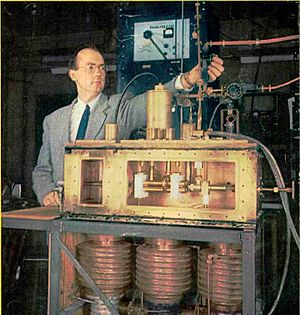Maser facts for kids

A maser is a special device that makes very focused waves, similar to powerful radio signals. It works by making tiny particles called atoms release energy in a very specific way. This energy then creates waves that are all very similar, like a perfectly tuned choir.
The word MASER is actually an acronym. It stands for Microwave Amplification by Stimulated Emission of Radiation. This means it makes microwaves (a type of radio wave) stronger by "stimulating" atoms to release their energy.
Contents
What is a Maser?
A maser is like a super-powered amplifier for atoms. Imagine you have a group of atoms, and they are all a bit "excited" with extra energy. A maser helps them release this energy all at once, in a very organized way. When they release this energy, it comes out as a wave.
How Masers Work
Masers use a clever trick called "stimulated emission." Think of it like this:
- First, atoms are given extra energy, making them "excited."
- Then, a special wave (a "seed" wave) passes by these excited atoms.
- This seed wave "stimulates" or encourages the excited atoms to release their energy.
- When they release energy, they add to the seed wave, making it much stronger. This is the "amplification" part.
The waves produced by a maser are very pure and focused. They are all nearly the same wavelength, which means they are very orderly. This makes them useful for many things.
History of the Maser
The idea behind masers was first thought of by the famous scientist Albert Einstein in the early 1900s. He described how atoms could be "stimulated" to release light.
However, it wasn't until the 1950s that the first working maser was built.
- In 1953, Charles Hard Townes and his students at Columbia University built the first ammonia maser. This device used ammonia gas to create microwave signals.
- Around the same time, scientists in the Soviet Union, Nikolay Basov and Alexander Prokhorov, were also working on similar ideas.
- For their groundbreaking work, Townes, Basov, and Prokhorov shared the Nobel Prize in Physics in 1964.
From Masers to Lasers
In the 1960s, scientists found a way to make devices similar to masers, but instead of producing microwaves, they produced visible light. These new devices were called lasers. The word LASER stands for Light Amplification by Stimulated Emission of Radiation. So, a laser is basically a maser that works with light instead of microwaves!
Uses of Masers Today
Even though lasers are more common in everyday life, masers are still very important for special jobs.
- Atomic Clocks: Some of the most accurate clocks in the world, called atomic clocks, use masers. These clocks are so precise that they can measure time almost perfectly, losing only about one second every few million years! They are used in things like GPS systems.
- Radio Astronomy: Scientists use masers to listen to very faint radio signals from space. Masers can amplify these weak signals without adding much noise, helping astronomers study distant stars and galaxies.
- Deep Space Communication: When we send probes to other planets, masers are used to send and receive signals over vast distances. They help make sure the messages are clear and strong.
- Quantum Computing: Scientists are exploring ways to use masers in new types of super-fast computers called quantum computers.
Images for kids
See also
 In Spanish: Máser para niños
In Spanish: Máser para niños


